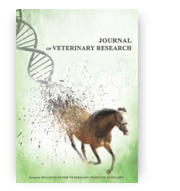Examination of the haematological profile of pregnant Polish Holstein-Friesian black-and-white cattle in the early stage
Marcjanna Wrzecińska; Alicja Kowalczyk; Ewa Czerniawska-Piątkowska; Władysław Kordan; Jose Pedro Araujo
Journal of Veterinary Research
Ministerial score = 200.0
Journal Impact Factor (2023) = 1.8 (Q2)
 Introduction: Cattle health and welfare are monitored via the analysis of the haematological profile, and it shows cattle’s ability to adapt to changing environmental conditions, pregnancy and lactation; profile changes also indicate reproductive disorders. The literature lacks reports of the examination of the haematological profile in cows up to the 50th day of pregnancy (dop). Therefore, this research examined that in cows up to this pregnancy stage. Material and Methods: A total of 101 Polish Holstein-Friesian black-and-white cows were divided into groups. The control groups consisted of non-pregnant heifers (group C00) and non-pregnant cows (group C0), and the experimental groups were pregnant heifers (group T1 at dop ≤ 28 and group T2 at dop ≥ 29–dop < 45) and pregnant cows (group T3 at dop ≥ 29–dop ≤ 50). In addition, the T3 group was divided into cows pregnant for up 45 dop and cows between 45 and 50 dop. Blood samples were collected in March and April 2021 from each animal and analysed. A transrectal ultrasound examination was performed to detect and confirm pregnancy. Results: Statistically significant differences (P ≤ 0.01) between the group of cows at dop < 45 dop and those at dop ≥ 45–dop ≤ 50 dop were noted in granulocyte percentage (GRA%), white and red blood cell counts (WBC/RBC), platelets (PLT), platelet distribution width (PDW), haematocrit (HCT) and lymphocyte percentage (LYM%). No statistically significant differences were found in the mean corpuscular haemoglobin, monocytes (MON), monocyte percentage (MON%), mean platelet volume (MPV), thrombocrit or red blood cell distribution width (RDW). Similar statistically significant differences (P ≤ 0.01) emerged between the groups of heifers in PLT, GRA, RBC, lymphocytes, LYM% and HCT, and no significant differences were found between MPV, MON, MON% or RDW. Conclusion: Examining the haematological profile in high-yielding cattle is vital in maintaining herd profitability and high reproduction, which depend on the quick diagnosis of disorders facilitated by haematology. This study analysed the haematology profile of dairy cattle at dop ≤ 50 for the first time, indicating changes in lymphocyte levels, which suggests that the animals experienced direct stress during the study.
Introduction: Cattle health and welfare are monitored via the analysis of the haematological profile, and it shows cattle’s ability to adapt to changing environmental conditions, pregnancy and lactation; profile changes also indicate reproductive disorders. The literature lacks reports of the examination of the haematological profile in cows up to the 50th day of pregnancy (dop). Therefore, this research examined that in cows up to this pregnancy stage. Material and Methods: A total of 101 Polish Holstein-Friesian black-and-white cows were divided into groups. The control groups consisted of non-pregnant heifers (group C00) and non-pregnant cows (group C0), and the experimental groups were pregnant heifers (group T1 at dop ≤ 28 and group T2 at dop ≥ 29–dop < 45) and pregnant cows (group T3 at dop ≥ 29–dop ≤ 50). In addition, the T3 group was divided into cows pregnant for up 45 dop and cows between 45 and 50 dop. Blood samples were collected in March and April 2021 from each animal and analysed. A transrectal ultrasound examination was performed to detect and confirm pregnancy. Results: Statistically significant differences (P ≤ 0.01) between the group of cows at dop < 45 dop and those at dop ≥ 45–dop ≤ 50 dop were noted in granulocyte percentage (GRA%), white and red blood cell counts (WBC/RBC), platelets (PLT), platelet distribution width (PDW), haematocrit (HCT) and lymphocyte percentage (LYM%). No statistically significant differences were found in the mean corpuscular haemoglobin, monocytes (MON), monocyte percentage (MON%), mean platelet volume (MPV), thrombocrit or red blood cell distribution width (RDW). Similar statistically significant differences (P ≤ 0.01) emerged between the groups of heifers in PLT, GRA, RBC, lymphocytes, LYM% and HCT, and no significant differences were found between MPV, MON, MON% or RDW. Conclusion: Examining the haematological profile in high-yielding cattle is vital in maintaining herd profitability and high reproduction, which depend on the quick diagnosis of disorders facilitated by haematology. This study analysed the haematology profile of dairy cattle at dop ≤ 50 for the first time, indicating changes in lymphocyte levels, which suggests that the animals experienced direct stress during the study.
DOI:10.2478/jvetres-2023-0043









